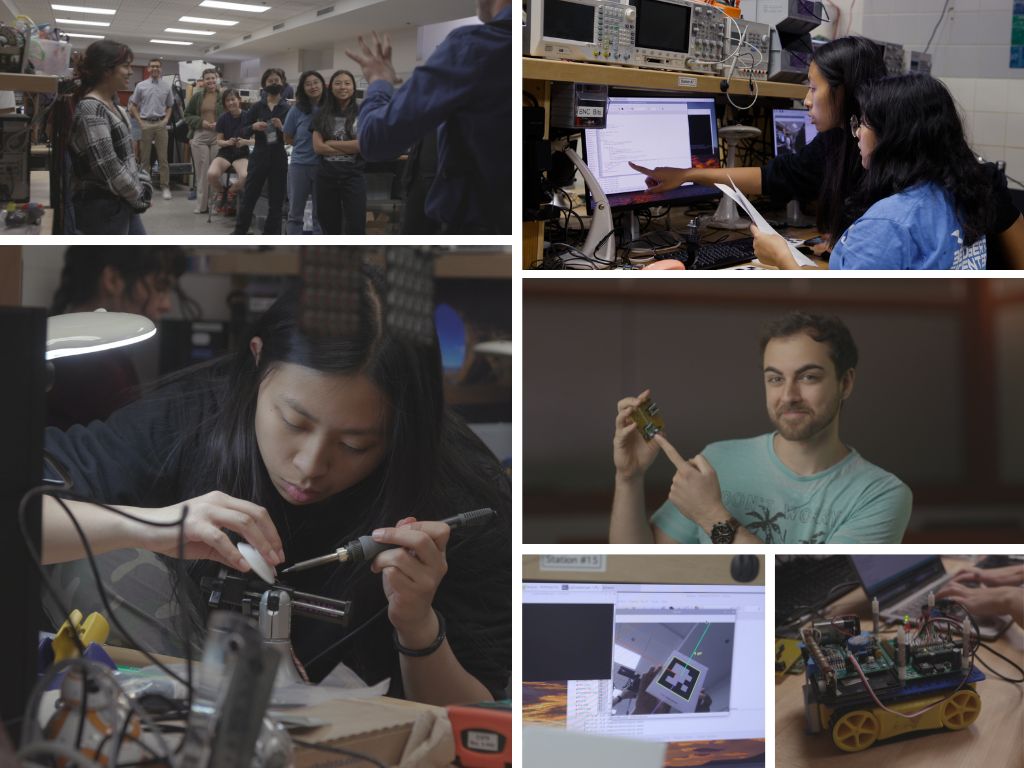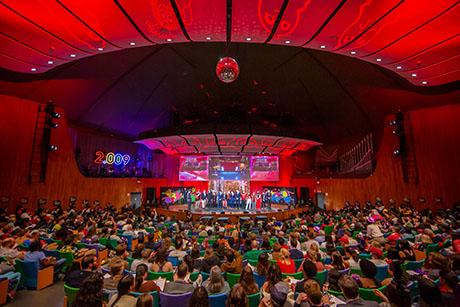'Imagine it, build it' describes spirit of 2.679 (Electronics for Mechanical Systems II)
Hands-on approach provides the skills engineers use to create and solve problems
2.679 (Electronics for Mechanical Systems II) offers a sort of alchemy that transforms students from consumers of knowledge to explorers and innovators, and equips them with a range of important new tools at their disposal, students say.
“Topics which could otherwise feel intimidating are well-scoped each week so that students come out knowing not only what a concept is, but why it’s useful and how to actually implement it,” says graduating senior Audrey Chen. “I could consistently come in with no background and come out with practical experience I could use in future projects. I’d describe the class as a series of small crash courses [each of which] answers, simply, ‘what do I need to know to do or use this thing?’”
The course takes students through the process of design, fabrication, and assembly of a printed circuit board (PCB). Ultimately, that process, which has twists and turns depending on each student’s project idea, culminates in the incorporation of the PCB into a device — in a sense animating that device to perform a certain function.
“The design intent of 2.679 is to empower students to ‘imagine it, build it,'" says Tonio Buonassisi, professor of mechanical engineering. "Between those two is a universe, and the purpose of this class is to aid aspiring engineers to bridge that gap.”
Senior Jessica Lam marvels at how much she learned in the course over its one short semester, attributing that flood of education to the class labs being “incredibly well-structured.”
“I’ve found that in a lot of other labs and project-based classes, they throw a lot of information at you at once with the expectation that you already have some experience with certain software or hardware and most of it is scaffolded and feels like a black box,” without much understanding of what is actually happening, Lam says. "In 2.679, [technical instructor]
Steve Banzaert has a better understanding of what we already know and how to build on that."
After taking 2.679, she says she feels “a lot more confident in designing electrical systems, and I have a more comprehensive understanding of how to integrate mechanical systems and electronics.”
Banzaert says the class is designed to guide students along their own chosen paths of discovery, showing them that they are able to address the challenges they encounter along the way.
“Every semester we get to see really lovely examples of growth, not just in the course material but, in the best cases, in students’ understanding of what they’re really capable of,” he says.
Chen, a mechanical engineering major who is graduating early to start a position as a hardware project manager at Formlabs, agrees that the class did just that.
“Students are given tremendous freedom to pick their own final projects, allowing them to explore topics which are of special interest to them. And because each project is unique, there is less pressure to ‘perform’ in a traditional sense,” she says. “Rather, each student is learning different skills and is encouraged to get as far along with the project they choose as possible. Steve emphasized that the scope of our projects would inevitably change, because at the start you simply don’t yet know what you don’t know, and that’s totally okay!”
Banzaert says, “We try to make it very clear that, yes, we are talking about important general concepts in theory and analysis, but that’s because they are tools that engineers use to solve problems. I think maybe this focus helps remind the students of what got them here in the first place — that the reason you’re an engineer is because there’s something about the world you wish was better, that you’re the person to do it (or at least help), and, if you want to do it well, you’re going to have to learn a bunch of things so you have more tools in your toolbox.”
Senior Yasin Hamed designed a car in the class that uses computer vision to follow along a black line. The car has an attached camera that captures images and relays them to a Raspberry Pi computer that is also attached to the car. Processing the images in real time allows the car to locate the black line and turn or go straight while controlling the car’s speed.
Although Hamed, who is majoring in mechanical engineering with a minor in computer science, had built another similar system in a previous class, he says the focus in the prior class was on the software. With his 2.679 car project, he learned about “the underlying foundation,” meaning “the design of the power electronics and control circuitry which is necessary for everything else to work.”
“I derived much of the ‘enlightenment’ from this class from the little electronic bits and pieces of information I picked up along the course of the class, like learning/practicing soldering, understand how to use integrated circuits, learning how to design a PCB, etc.,” he says. “It was the collection of all of these things that benefitted me the most.”
Jordan Parker-Ashe, also a senior, appreciated how 2.679 combined lessons about electronics with research and presentations from Buonassisi’s lab. “It’s great seeing engineering applied in research,” she says.
Although many of the skills she learned in the course were new to her, one was “an old foe,” she says, that 2.679 allowed her to befriend. Parker-Ashe, who is majoring in nuclear engineering, had used a computer vision program called Open CV in her first University Research Opportunities Program (UROP) as a first-year undergraduate.
“It was the hardest thing ever, and it really felt like an insurmountable obstacle then,” she says. “Now, to be using OpenCV in labs and homework effortlessly — It was a very full-circle moment.”
She says the class has opened up a whole new field to her, with Banzaert having “directly inspired” her to also take 6.131 (Power Electronics), “which has been life-changing,” she says.
“2.679 helped me believe in myself, which inspired me to take 6.131, a notorious electrical engineering capstone, which has made me realize that my future lies as a nuclear-electrical engineering engineer, not just a nuclear engineer,” Parker-Ashe says. “I want to pursue electrical engineering in my future, and that just wasn’t on the table beforehand.
“Not to mention that it’s opened the doors to very rich landscapes for project ideas, creating explorations, art, stepping into new roles in group projects, etc,” she says. "I'm so glad that I've been able to find opportunities in Course 2 that helped give me hands-on, applied engineering experience."




